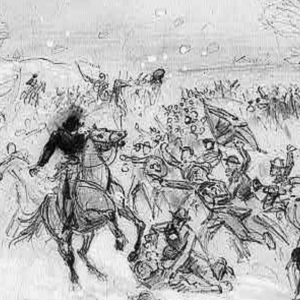The Bible speaks of beating swords into plowshares. More than 160 years ago, soldiers in the American Civil War briefly gave up guns for another weapon, courtesy of Mother Nature.
Before we delve too deep into this story, it’s important to understand that men on both sides of the battle spent most of their enlistment in army camps. Looking at the old photos from the war, it seems almost idyllic now. Glistening white canvas tents, fresh country air, green grass and trees all around. But as is so often the case, the reality was quite different.
Camp life was a case study in mind-numbing monotony. Wake up, fall in for roll call, maybe spend an hour in drills, perhaps pass another hour cleaning your gun and equipment. And that was it. Seven days a week with no interruption, sometimes for months. Remember, too, the majority of the troops were young guys in their late teens and 20s, an age group that considers inactivity a personal insult.
As one twentysomething Federal wrote to his girlfriend, “The talk here is that we will have a battle before too long. The sooner we do, the better, for I am mighty tired of staying here penned up in camp.”
Nature delivered a welcome distraction in the first days of February 1862, and Henry Seymour Lansing spotted an opportunity to shake up camp life’s tedious routine.
A big, burly man just days shy of turning 38, he was the colonel in command of the 17th New York Infantry. When northern Virginia was blanketed by more than a foot of fresh snow, he had an idea that could give his men a little excitement.
In a letter home, George Westfall, a private in Company D, described what happened next.
“The colonel got the men out on Monday morning and had us roll snowballs and build a snow fort. They worked all morning. In the afternoon, he had the men divided into two parties and put one party in the fort and the other party outside of the fort. There were eight hundred out in the whole besides the officers, and they had all them snowballs and were to see which party would whip the other.
“I was in the party outside the fort. We whipped the other party and drew them out of the fort. I got one black eye and was glad to get off with just that. It was the biggest snowball fight I ever saw. It was in the Washington papers the next day.”
Watching 800 men go at each other with snowballs was quite a spectacle. Word of the welcome diversion spread to other New York regiments, which soon hosted mock battles. In some cases, entire regiments attacked one another. The Sunday Dispatch newspaper in New York City carried this brief article on Feb. 23:
“SHAM BATTLES—The soldiers in Virginia have been amusing themselves with a snowball fight. A correspondent sends an account of one between the 31st and 32nd New York regiments on Feb. 4th, which lasted two hours and resulted in the victory of the latter. The 31st had their colonel taken prisoner by the 32nd and, despite every effort, failed to rescue him.”
Southerners also got in on the fun. Snow was a novelty to soldiers from the Deep South, who especially relished playing in it. A year later, South Carolinians serving in Virginia waded through the white stuff to take on their comrades in arms from Alabama and Mississippi in a sport the men called “snowballing.”
The Mother of All Snowball Battles was fought by the South the following year. An especially heavy late winter snowfall covered Dalton, Ga., in late March 1864.
On the 22nd, a handful of soldiers were horsing around in it. Someone dared a young Tennessee private named J.W. Mewborn to see if he could throw a snowball over a small creek. He did — hitting a Georgian in the back. Unamused, the Peach State warrior promptly patted out a snowball of his own and fired back.
Snowballs were rapidly rolled and lobbed. Friends on both sides ran over and jumped into the action as the fighting escalated. Officers rushed up to take command with battle flags unfurled, bugles blaring, and drums pounding.
The battle eventually had snowballs flying between 6,000 men stretched out for over two miles in a division strength contest that lasted all day. As often happens when roughhousing gets out of control, dozens of soldiers were sent to the hospital with injuries. In an army already desperately deficient in troops, such needless losses could not be tolerated. The Confederate high command issued an order the next day, essentially saying, “Knock it off!”
Still smaller, less dramatic snowball fights continued through the war’s final winter in 1865. Proving then as now the truth in the old saying, “Boys will be boys.”





